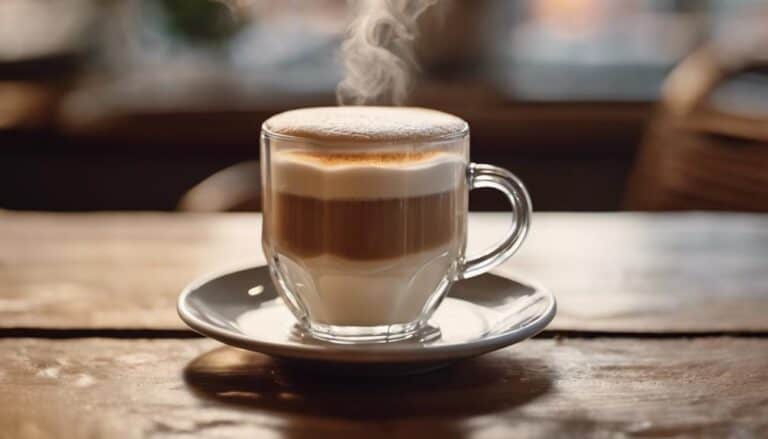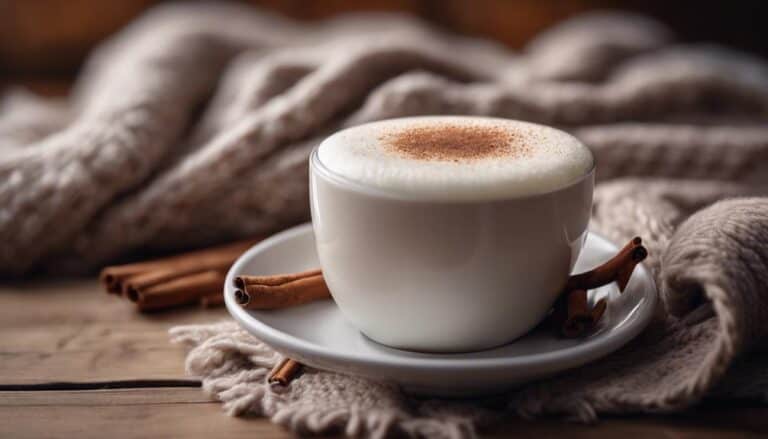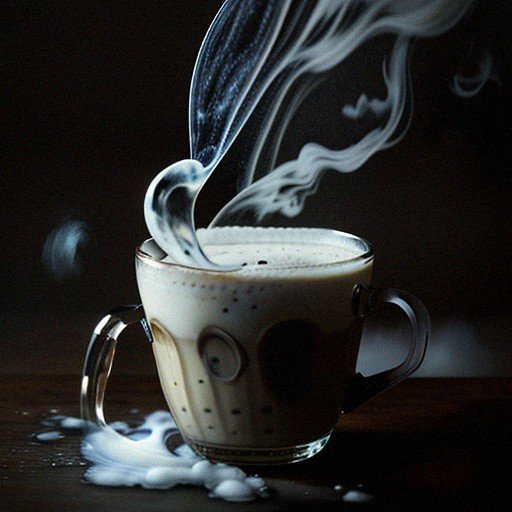10 Key Differences Between Cappuccino Espresso and Latte

When it comes to coffee, the saying 'variety is the spice of life' couldn't be more accurate.
We're about to uncover the nuances and subtleties that distinguish cappuccino, espresso, and latte.
Understanding the key differences between these beloved Italian brews might just reshape your coffee routine.
So, let's unravel the intricacies of these caffeinated delights and discover what sets them apart.
History and Origin
When delving into the history and origin of coffee, espresso, latte, and cappuccino, it becomes evident that these iconic beverages trace their roots back to the rich coffee culture of Italy. Espresso, with its bold flavor profile, is a concentrated coffee brewed under pressure, exemplifying the Italian passion for intense coffee experiences. Latte, a milder option, combines one-third espresso with two-thirds steamed milk, showcasing Italy's ability to balance strong flavors with creamy textures. Cappuccino, named after Capuchin monks, blends equal parts espresso, steamed milk, and microfoam, creating a rich and velvety drink that symbolizes the depth of Italian coffee craftsmanship.
Italy's influence on coffee culture is undeniable, as these beverages have become synonymous with the country's dedication to perfecting the art of coffee-making. The origins of espresso, latte, and cappuccino reflect a tradition deeply rooted in Italian history, where each sip tells a story of innovation and passion for the perfect cup of coffee.
Basic Characteristics
As we explore the basic characteristics of espresso, latte, and cappuccino, their distinct compositions and flavor profiles come to the forefront, showcasing the unique appeal of each iconic coffee beverage. Espresso stands out with its 100% concentrated espresso content, delivering a robust flavor profile that packs a punch with approximately 63 mg of caffeine per shot.
On the other hand, latte strikes a different chord, blending 1/3 espresso with 2/3 steamed milk, resulting in a creamier texture and milder taste, offering around 173 mg of caffeine in a 16 oz serving.
Cappuccino, named after Capuchin monks, finds a harmonious balance with equal parts espresso, steamed milk, and microfoam, providing a rich and fulfilling experience with approximately 130 calories in a 16 oz serving. Espresso is celebrated for its strong flavor, while latte offers a smoother, creamier experience, and cappuccino brings together the best of both worlds with its rich texture and balanced flavors.
Preparation and Ingredients
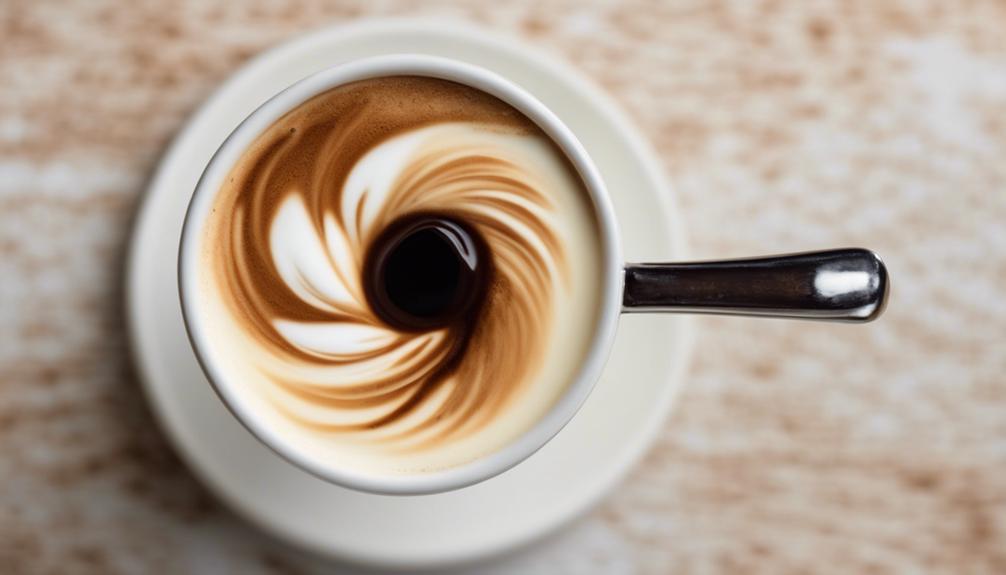
Crafting a flavorful cappuccino, espresso, or latte involves precise techniques and a careful selection of quality ingredients to ensure a harmonious balance of flavors and textures. Starting with espresso, this intense and concentrated coffee shot is prepared by forcing hot water through finely ground coffee beans under high pressure.
On the other hand, a cappuccino is a well-balanced mix of espresso, steamed milk, and milk foam, with a milk-to-espresso ratio of 1:1:1, creating distinct layers in the drink. This results in a harmonious blend of coffee flavor and smooth texture.
In contrast, a latte consists of a base of espresso combined with steamed milk, with a milk-to-espresso ratio of 1:2, offering a milder coffee taste and creamier texture compared to a cappuccino. These varying ratios significantly impact the taste, texture, and richness of each beverage, catering to different preferences for coffee enthusiasts.
Caffeine Content and Calories
With varying levels of caffeine and calorie counts, understanding the differences among cappuccino, espresso, and latte can assist in making informed choices based on individual preferences and dietary needs.
Espresso, known for its concentrated flavor, contains around 80 mg of caffeine and 10-15 calories in a 2 oz shot. A 12 oz coffee typically has 120 mg of caffeine and 2-5 calories.
Latte, offering a creamier texture, packs approximately 173 mg of caffeine and 210 calories in a 16 oz serving, making it higher in both caffeine and calories compared to cappuccino. A 16 oz cappuccino contains similar caffeine content to a latte but fewer calories, around 130.
The choice of milk can also impact the calorie content, with whole milk adding more calories compared to skim milk or plant-based alternatives. When considering your caffeine intake and calorie consumption, these differences among espresso, latte, and cappuccino can guide you towards the option that best fits your preferences and dietary requirements.
Popular Variations and Flavors
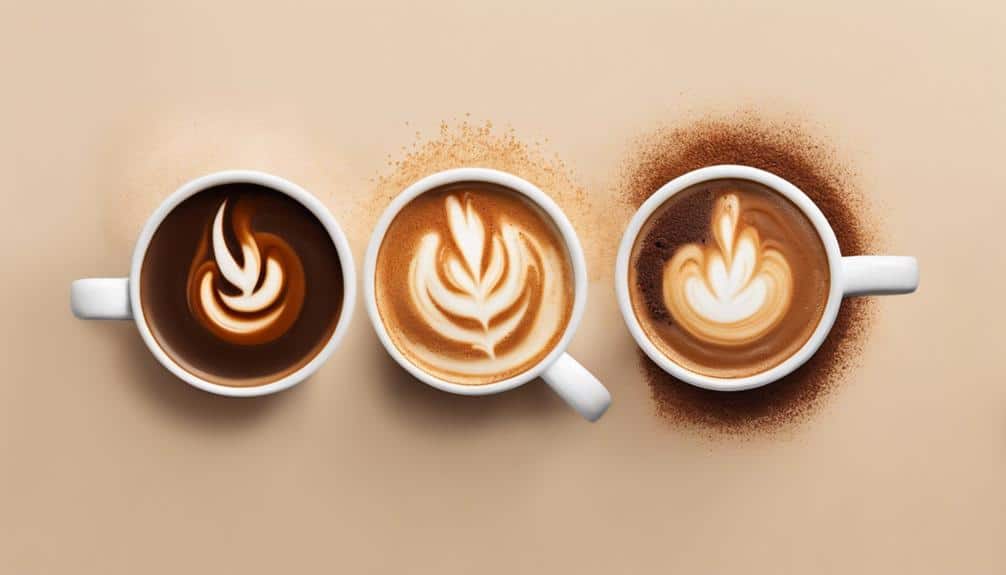
What unique flavors and variations distinguish cappuccino, latte, and espresso from each other, enhancing the coffee-drinking experience for enthusiasts? Cappuccino stands out with its sprinkle of cocoa powder or cinnamon on top, adding a delightful touch to the rich espresso and velvety steamed milk. Latte, on the other hand, offers a creamy base that can be further enhanced with syrups like vanilla or caramel, providing a sweet and aromatic experience. For chocolate enthusiasts, the mocha is a perfect choice, combining espresso, steamed milk, and chocolate for a decadent treat.
Each of these beverages caters to different taste preferences, from those who enjoy the subtle bitterness of espresso complemented by the sweetness of steamed milk in a latte, to the more pronounced flavors of cocoa powder or cinnamon in a cappuccino. The versatility of adding flavors like vanilla or caramel allows for endless customization, ensuring that there's a perfect coffee creation for every palate.
Finely-Ground Coffee and Brewing
Having explored the unique flavors and variations that distinguish cappuccino, latte, and espresso, we now turn our attention to the intricacies of finely-ground coffee and brewing techniques that define these beloved coffee beverages.
When it comes to crafting the perfect cup of espresso, cappuccino, or latte, the quality of the finely-ground coffee beans and the brewing methods employed play a crucial role. Here are some key points to consider:
- Espresso is extracted from finely-ground coffee beans that are tightly packed into a portafilter, allowing for high-pressure brewing that yields a concentrated and bold flavor.
- Cappuccino combines equal parts of frothed milk and espresso with finely-ground coffee beans, striking a harmonious balance between the rich espresso and creamy milk.
- Latte, on the other hand, incorporates a single or double shot of espresso with steamed milk, offering a smoother and creamier texture compared to cappuccino.
- The brewing process for all three beverages involves using freshly ground coffee beans to ensure optimal flavor extraction and richness.
- Each beverage has specific brewing methods tailored to highlight the unique characteristics of finely-ground coffee beans in varying milk ratios, resulting in a diverse range of flavors and textures.
Strength and Flavor Profile
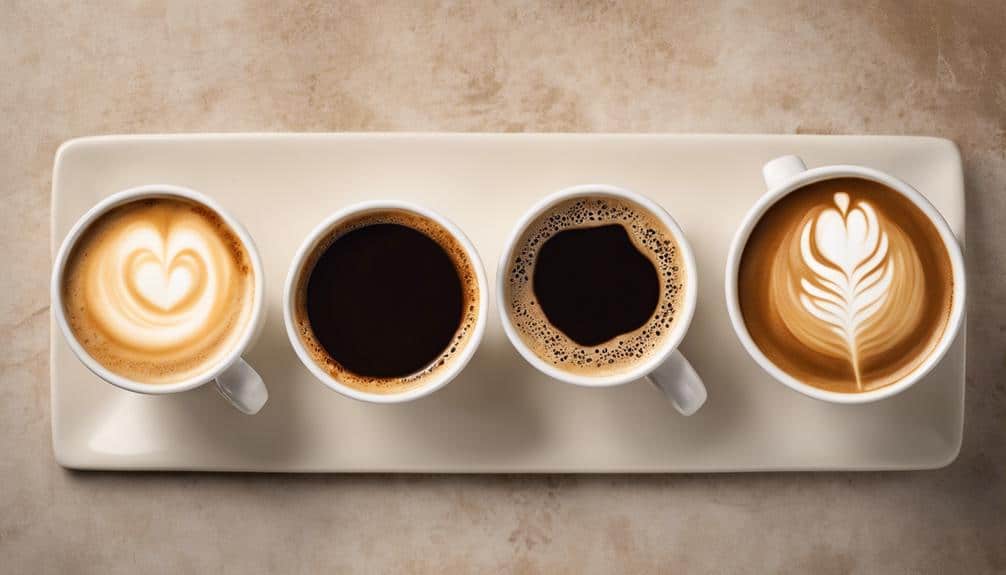
Exploring the strength and flavor profiles of espresso, cappuccino, and latte reveals their distinct characteristics and caffeine content. Espresso stands out for its robust and concentrated flavor, packing around 63 mg of caffeine per single shot. This intense brew is the foundation of both cappuccino and latte.
Cappuccino, on the other hand, strikes a balance between espresso, steamed milk, and foam, resulting in a harmonious blend of flavors. With approximately 130 calories, cappuccino offers a creamy texture and a slightly milder coffee taste compared to espresso.
Latte, with its higher milk ratio, delivers a smoother and more subdued coffee flavor, containing about 210 calories per serving. The increased milk content in lattes dilutes the strength of the espresso, making it a popular choice for those seeking a more mild coffee experience. Each of these beverages offers a unique taste profile, catering to a variety of preferences.
Milk Frothing and Texture
Moving from the strength and flavor profiles to milk frothing and texture, we observe how the preparation method plays a crucial role in shaping the overall experience of cappuccino and latte.
In cappuccino, the dense microfoam layer created through milk frothing provides a rich and creamy texture, while the steamed milk with a small layer of frothed milk in latte offers a smooth and velvety mouthfeel. The distinct layers in cappuccino, achieved by frothing the milk separately from the espresso, give it a unique texture. On the other hand, the integration of frothed milk with steamed milk in latte results in a more unified texture.
- The dense microfoam layer in cappuccino creates a rich and creamy texture.
- Latte's combination of steamed milk and frothed milk offers a smooth and velvety mouthfeel.
- Cappuccino's frothed milk is prepared separately from the espresso, providing distinct layers.
- Latte's frothed milk is mixed with steamed milk for a more integrated texture.
- Personal preference can determine the texture of cappuccino's foam, ranging from dry and airy to smooth and velvety.
Espresso Shot Vs. Steamed Milk Ratio
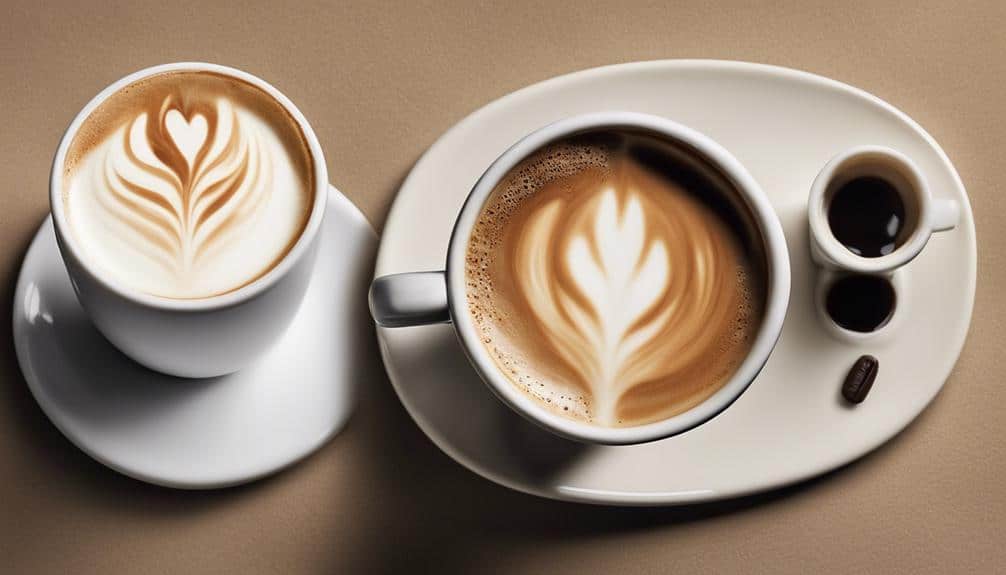
When considering the espresso shot versus steamed milk ratio in coffee beverages, the balance of flavors is key.
The intensity of the espresso, the creaminess of the steamed milk, and the foam all contribute to the overall taste experience.
Understanding how these elements harmonize in each drink is crucial for coffee enthusiasts seeking their perfect cup.
Espresso to Milk Ratio
With the espresso to milk ratio playing a crucial role in defining the characteristics of cappuccino, latte, and espresso, understanding this balance is fundamental in distinguishing between these popular coffee beverages.
When considering the espresso to milk ratio, there are several key points to keep in mind:
- The ratio determines the intensity of the coffee flavor in the beverage.
- A higher milk content creates a creamier texture.
- Espresso provides the base flavor for both cappuccino and latte.
- The ratio affects the overall strength of the drink.
- Finding the perfect balance is essential for achieving the desired taste experience.
Steamed Milk Volume
What distinguishes the steamed milk volume in a latte from an espresso shot, and how does this affect the overall flavor profile of each coffee beverage?
In a latte, the steamed milk covers around two-thirds of the drink, creating a creamy and milder taste compared to the intense and concentrated flavor of an espresso shot. This difference in milk volume plays a significant role in shaping the overall flavor experience.
The espresso shot, with minimal milk content, offers a bold and robust coffee flavor, while the latte, with its higher steamed milk ratio, provides a smoother and more balanced taste. Understanding this variance in steamed milk volume between espresso and latte is key to appreciating the richness and nuances that each beverage brings to the palate.
Balance in Espresso
The balance between espresso and steamed milk in a coffee beverage plays a crucial role in determining its overall flavor profile and texture. When considering the ratio of these components, it's essential to achieve harmony to deliver a satisfying experience.
Here are some key considerations to keep in mind when balancing espresso with steamed milk:
- Concentrated Flavor: Espresso offers an intense and robust flavor profile due to its high coffee-to-water ratio.
- Foamy Texture: The inclusion of foam adds a velvety texture and enhances the overall mouthfeel of the drink.
- Perfect Harmony: Achieving a balanced ratio of espresso, steamed milk, and foam is vital for a well-rounded taste.
- Richness: The right combination of these elements creates a rich and creamy beverage that delights the palate.
- Personal Preference: Adjusting the ratio allows for customization to suit individual taste preferences.
Serving Vessels and Presentation
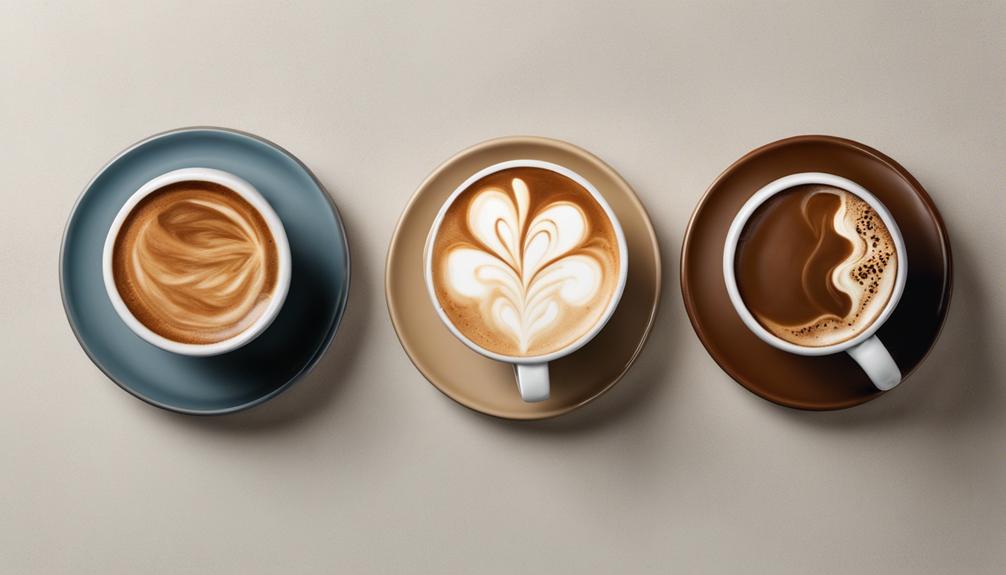
When it comes to the serving vessels for cappuccinos, espressos, and lattes, the size and shape of the cups play a crucial role in enhancing the overall presentation.
Cappuccinos are typically served in smaller cups to emphasize the layers of espresso, steamed milk, and foam, while lattes are often showcased in taller glasses to display the distinct layers of ingredients.
Additionally, the art of foam design on top of cappuccinos adds an aesthetic touch to the presentation, enhancing the overall coffee-drinking experience.
Cup Sizes
In exploring the presentation of cappuccinos, espressos, and lattes, the cup sizes used play a pivotal role in highlighting the unique characteristics of each beverage. The cup sizes not only affect the visual presentation but also influence the flavor profiles by determining the milk ratios and overall balance of the drink.
Here are some key points to consider:
- Cappuccinos in smaller cups accentuate the layers of espresso, steamed milk, and foam.
- Espresso shots shine in small demitasse cups, showcasing their intense flavor.
- Lattes often come in taller glasses, emphasizing a higher milk content.
- The choice of serving vessels helps differentiate between the beverages based on their coffee-to-milk ratios.
- Specific cup sizes enhance the overall appeal and aid in identifying the distinct flavors of cappuccinos, espressos, and lattes.
Foam Art
Crafting intricate foam art to enhance the presentation of cappuccinos, espressos, and lattes requires skill and precision in the coffee-making process. Latte foam art often showcases detailed designs like hearts or leaves, achieved by skillfully pouring steamed milk into espresso.
Cappuccinos, traditionally adorned with a sprinkle of cocoa powder or cinnamon, offer visually appealing presentations. Unlike lattes and cappuccinos, espresso is typically served in small 'demitasse' cups without elaborate foam art due to its concentrated nature.
Baristas frequently demonstrate their talents through latte art, creating visually stunning designs on the milk foam. Cappuccino foam texture can vary, with some preferring a drier foam to emphasize the contrast in layers. The artistry of milk designs adds an aesthetic dimension to the espresso's concentrated richness.
Conclusion
In conclusion, understanding the key differences between cappuccino, espresso, and latte allows coffee enthusiasts to appreciate the unique characteristics and flavors of each beverage.
From the rich and creamy texture of a cappuccino to the bold and intense flavor of an espresso, there's a diverse range of options to suit every coffee lover's preferences.
By exploring the history, preparation methods, and variations of these classic Italian drinks, one can truly savor the art of coffee culture.

